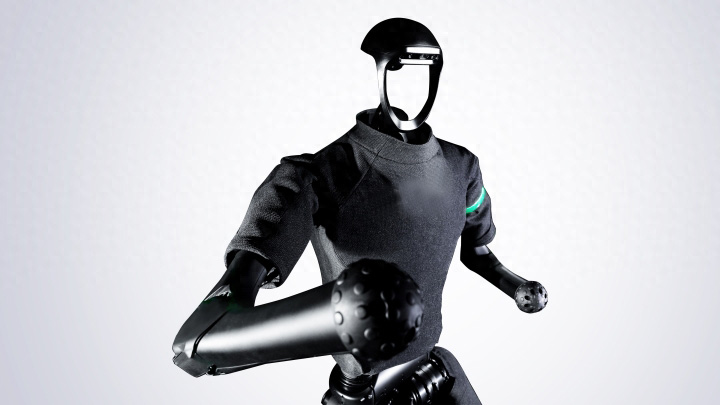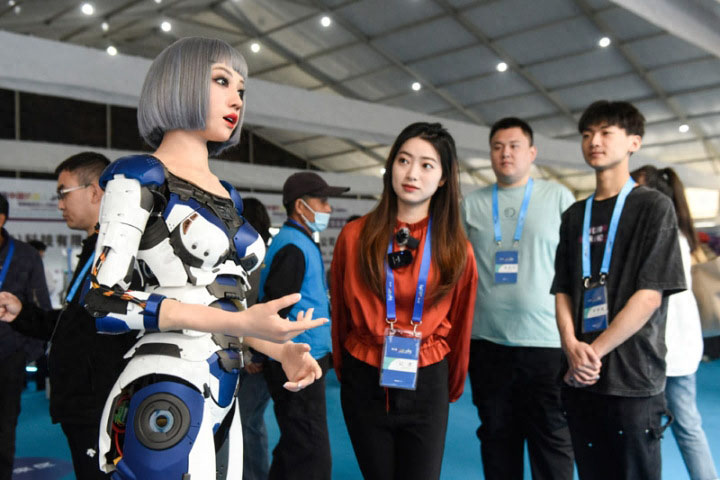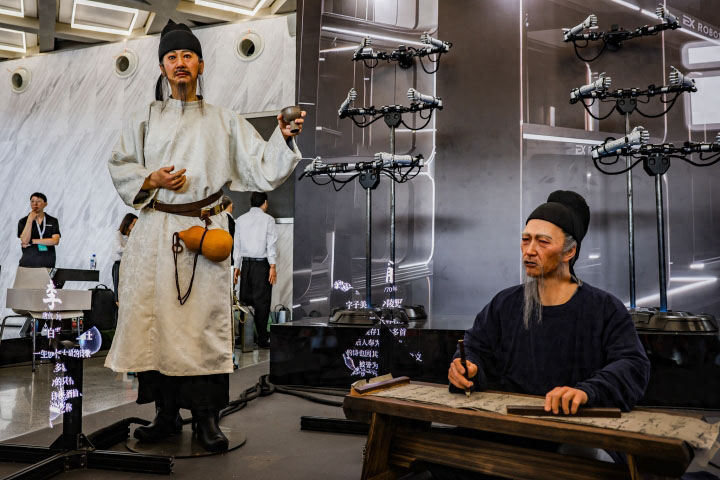Recently, the 75-year-old "AI godfather" Geoffrey Hinton left Google and quit AI again. He officially announced that he has joined the advisory board of robotics company Vayu Robotics to help develop AI robot solutions. The robot launched by Disney that resembles "Wall-E" has a flat head and a square body. It can not only jump around, but also express emotions. It has attracted many netizens to say that they want to take it home!
Disney’s robot IROS interacts with people
Robots are getting closer to humans, but will they replace us?
In a video released by Tesla, the humanoid robot "Optimus Prime" accurately uses each joint to smoothly complete the transportation and assembly tasks of the robotic arm, achieving "build yourself." Recently, "Optimus Prime" has evolved again. Not only can it sort items by "seeing", but it can also do yoga on one leg. Compared with other robots, its application scenarios are more versatile. This time it breaks the barriers of factory and home use, and its commercialization is expected to be further strengthened.
In October last year, when "Optimus Prime" debuted, its wiring harness and circuit board were still exposed. "That's it?!" A group of technology enthusiasts expressed their disappointment, saying that they only relied on people to carry them to power. Even Musk himself was worried that it would fall into the audience and fall on the face of a "lucky person" as it walked independently for the first time without a leash.
"Optimus Prime" in "Build Yourself" Source: Tesla official social platform
Nowadays, my country's humanoid robots have also ushered in a period of concentrated explosion: Xiaomi's "Tieda", Yushu Technology's H1, Zhejiang University School of Control Robotics Team's "Wukong-4" and other domestically produced humanoid robots have appeared together, or Walk, or run, or demonstrate grasping, or talk to someone.
How did this happen? Why are people optimistic about humanoid robots? How will it change existing industries and our lives?
A dream come true
On the way to Hangzhou Yushu Technology Co., Ltd., the reporter had doubts about the navigation more than once: remote neighborhoods, old white buildings... there seemed to be no trace of "high technology" here.
However, the moment the elevator door opened, it was as if a virtual ticket to the sci-fi city "dingdong" was entered: bright lights, empty exhibition halls, cyberpunk-style decorations hit the pupils directly, and four-legged robots stepped on all sides. The sound made by the joint movement when jumping.
Inside and outside the house, it seems like two worlds.
Founded in 2016, Yushu Technology specializes in quadruped robots, which cost less than 10,000 yuan per unit and have led sales over the years. Now, taking advantage of Tesla's "Optimus Prime", the first general-purpose humanoid robot H1 is launched. Once released, it became popular all over the Internet. Andrej Karpathy, a founding member of OpenAI and former Tesla AI director, specially retweeted the official tweet and shouted "want to".
What is the charm of H1 like this?

Optimus Prime, IROS, Tieda, H1, Goku-4... the humanoid robots are here
2023-10-13 15:32·Qianjiang Evening News
Chao News Client Reporter Xie Danying
Recently, the 75-year-old "AI godfather" Geoffrey Hinton left Google and quit AI again. He officially announced that he has joined the advisory board of robotics company Vayu Robotics to help develop AI robot solutions. The robot launched by Disney that resembles "Wall-E" has a flat head and a square body. It can not only jump around, but also express emotions. It has attracted many netizens to say that they want to take it home!
Disney’s robot IROS interacts with people
Robots are getting closer to humans, but will they replace us?
In a video released by Tesla, the humanoid robot "Optimus Prime" accurately uses each joint to smoothly complete the transportation and assembly tasks of the robotic arm, achieving "build yourself." Recently, "Optimus Prime" has evolved again. Not only can it sort items by "seeing", but it can also do yoga on one leg. Compared with other robots, its application scenarios are more versatile. This time it breaks the barriers of factory and home use, and its commercialization is expected to be further strengthened.
In October last year, when "Optimus Prime" debuted, its wiring harness and circuit board were still exposed. "That's it?!" A group of technology enthusiasts expressed their disappointment, saying that they only relied on people to carry them to power. Even Musk himself was worried that it would fall into the audience and fall on the face of a "lucky person" as it walked independently for the first time without a leash.
"Optimus Prime" in "Build Yourself" Source: Tesla official social platform
Nowadays, my country's humanoid robots have also ushered in a period of concentrated explosion: Xiaomi's "Tieda", Yushu Technology's H1, Zhejiang University School of Control Robotics Team's "Wukong-4" and other domestically produced humanoid robots have appeared together, or Walk, or run, or demonstrate grasping, or talk to someone.
How did this happen? Why are people optimistic about humanoid robots? How will it change existing industries and our lives?
A dream come true
On the way to Hangzhou Yushu Technology Co., Ltd., the reporter had doubts about the navigation more than once: remote neighborhoods, old white buildings... there seemed to be no trace of "high technology" here.
However, the moment the elevator door opened, it was as if a virtual ticket to the sci-fi city "dingdong" was entered: bright lights, empty exhibition halls, cyberpunk-style decorations hit the pupils directly, and four-legged robots stepped on all sides. The sound made by the joint movement when jumping.
Inside and outside the house, it seems like two worlds.
Founded in 2016, Yushu Technology specializes in quadruped robots, which cost less than 10,000 yuan per unit and have led sales over the years. Now, taking advantage of Tesla's "Optimus Prime", the first general-purpose humanoid robot H1 is launched. Once released, it became popular all over the Internet. Andrej Karpathy, a founding member of OpenAI and former Tesla AI director, specially retweeted the official tweet and shouted "want to".
What is the charm of H1 like this?
H1 diagram (picture provided by interviewee)
At first glance, "Internet celebrity" H1 is about 1.8 meters tall and weighs 47 kilograms. He looks tall and thin. In addition to being a "preview of half a year's results", H1 has already become "human-like" with a small piece of soft pad attached to the end of the arm before I even have time to do my hands.
Humanoid robots, also known as "bionic humans". But whether it looks like a human or not is not the most important thing. "More technology stacks point to movement capabilities and the ability to operate 'hands'. Humanoid robots that move like humans and can flexibly operate external things with 'hands' are truly humanoid robots," said Wang Xingxing, founder of Yushu Technology.
In the "moving" module, as a leading company in quadruped robots, Yushu Technology has inherent advantages.
In the 55-second demonstration video: H1's chassis is stable and its pace is smooth. It can not only walk forward in big strides, but also run quickly in small steps. According to official data, its walking speed is greater than 1.5m/s, which is equivalent to the walking speed of an adult, and its potential movement ability is more than 5m/s. It is the first full-size general-purpose humanoid robot in China that can run.
In addition, the video also reproduces the "violent" challenge faced by the Boston Dynamics robot back then - being kicked from the side and back. After H1 stumbled slightly, it was able to quickly find a new balance. He even learned to anticipate, dodge in advance, and avoid flying kicks.
H1 part demonstration video (picture provided by interviewee)
This is an ordinary human operation. But for humanoid robots, the more "human-like" the movements are, the more complex the supporting technology is.
"There are two main difficulties." According to relevant staff, both the hardware structure system design of the whole machine and the motion control algorithm are challenges - humanoid robots mainly rely on two "legs" to alternately support the ground to achieve continuous sports. Each "leg" is equivalent to a 6-degree-of-freedom robotic arm, which has both series and parallel connections, and has a complex structure. At the same time, in order to walk more steadily and run faster, "this 12-degree-of-freedom robotic arm must be compact enough, light enough, and meet the impact load on the 'legs' of the entire humanoid robot when it runs and jumps." In addition, humanoid robots have a large number of joints, which means that it is difficult to accurately model the robot system. "Dual encoders are integrated within one joint." Under this algorithm framework, a large amount of resources are required to experiment and collect operating data, continuously adjust control parameters, and iterate repeatedly to achieve stable motion.
Such an achievement was achieved quickly in half a year. The staff told reporters that this is not unrelated to the migration of Yushu Technology's four-legged technology. It is reported that H1 uses and draws on accumulated quadruped technology in many aspects such as joint motors, electronic control systems, and control algorithms.
Although the technical routes are similar, they are different from "specialist" quadruped robots. "Generalist" humanoid robots are higher-dimensional existences. "There are still many technical bottlenecks that need to be broken through in the 'evolution' from quadrupeds to humanoids." Quite a few Industry insiders admit that domestic humanoid robots are still very basic.
Boston Dynamics humanoid robot Atlas (Source: Boston Dynamics official website)
So, why do people jump out of their comfort zones and get involved in the humanoid robot battlefield?
"Universal humanoid robots have always been considered the ultimate form of human robotics technology. Almost everyone who loves technology has had the idea of developing humanoid robots." In 2010, Wang Xingxing, a freshman, tried I used to make humanoid robots, "But it was a simple version that cost 200 yuan, and I still remember it."
A dream for 13 years, H1 can also be said to be a dream come true.
Thick "machine" thin hair
Humanoid robots are not a new concept.
From Westinghouse's crude Herbert Televox in 1927 to today's Tesla "Optimus Prime" prototype, the path of exploration of humanoid robots has gone through nearly a hundred years. This not only reflects mankind's fascination with the identity of the "creator", but also carries mankind's ultimate imagination of technology.
However, due to the current cost of hundreds of thousands of humanoid robots and technical difficulties, it has not been the main form of the robot industry.
Why will humanoid robots suddenly emerge this year and become so popular among capital?
"The popularization of AI large models has completed a missing core puzzle piece of humanoid robots." Industry insiders have said that previous technologies cannot control such complex robot forms of humanoid robots. "AI large models allow everyone to see '1 The -100' stage is no longer so difficult. If the industry solves the problem of the robot body in the '0-1' stage, the closed loop of humanoid robot landing can be predicted."
The "Wukong-4" of the Robotics Team of the School of Control of Zhejiang University was displayed at the 2023 World Robot Conference
In an offline seminar, some guests also mentioned that in the future, just as large models fission into large industry models in various industries, humanoid robots equipped with large industry models will also enter various industries.
At the same time, the reporter learned from the communication with the humanoid robot entrepreneurial team that at present, most parts of the humanoid robot industry can be replaced by domestic products. "Currently, chips are not a big problem. Domestic ones are enough." R&D personnel added.
Taking Zhejiang as an example, in terms of visual sensors, Hikvision, Zhejiang Dahua, etc. are close to the world's advanced level; in terms of natural language processing and response, Alibaba, Hangzhou Yizhi Intelligence, etc. have also accumulated experience for many years; in core components, such as the Chinese Academy of Sciences Ningbo The servo motors and double-ring transmission precision reducers of the Institute of Materials are among the best in the industry.
At the 8th China Robot Summit, the relevant person in charge told reporters that the Yuyao robot ecosystem centered on the "Robot Smart Valley Town" has gradually formed, with more than 100 companies settled in the core area and 83 upstream and downstream companies related to the robot industry chain. As companies settle in the surrounding area, "going up and downstairs means the upstream and downstream situation gradually emerges. This can be said to be the epitome of the full-chain development of Yuyao's robot industry."

The 8th China Robot Summit (Photo source: Xinhua News Agency)
In recent years, the development of hardware technology has made it possible to reduce the cost while maintaining the performance of humanoid robots high enough and agile enough. Take the "Expedition A1" as an example. Half a year after the genius boy Zhihui Jun left Huawei and created the Zhiyuan team, the humanoid robot built to compete with "Optimus Prime" will cost less than 200,000 yuan. Although it is still much higher than Musk’s predicted price of $20,000 (approximately 145,700 yuan) for Optimus Prime after mass production. However, this figure is far lower than Boston Dynamics’ US$2 million per unit, and it also falls within the budget range of many university robotics laboratories. For technology company buyers, the price is even cheaper.
Technical capabilities are the prerequisite, and practical needs are the important driving force.
Now with the blessing of large models, people are no longer satisfied with a robot being just a "specialist" controlled by code, but hope that it can master various skills through self-learning and interact with the surrounding environment in a more natural and intelligent way. Complete various tasks and become a truly conscious intelligent form.
EngineeredArts' humanoid robot Ameca shows off its rich facial expressions
Wu Zhaohui, deputy minister of the Ministry of Science and Technology and academician of the Chinese Academy of Sciences, said at the 2023 Zhongguancun Forum that the large natural language model represented by ChatGPT is not the final form of the large AI model. What is more advanced than it is multi-modal embodied intelligence. “The next wave of artificial intelligence is embodied intelligence.” Nvidia CEO Jensen Huang also predicted this in a speech this year.
"The demand for such products will far exceed Tesla cars in the future, reaching 10-20 billion units." Musk's remarks have injected more imagination into the humanoid robot market. According to predictions by Goldman Sachs, a well-known American investment bank, the humanoid robot market may reach US$154 billion by 2035, becoming another AI implementation scenario after smart driving electric vehicles.
Faced with the new trend of "embodied intelligence", at the beginning of this year, 17 ministries and commissions including the Ministry of Industry and Information Technology issued the "Implementation Plan for the "Robot+" Application Action." Subsequently, local governments such as Beijing, Shenzhen, and Shanghai also introduced policies to encourage the development and mass implementation of humanoid robot parts and complete products.
Driven by technology, capital boom, and policy support, in 2023, various companies will enter the humanoid robot track, and capital from all parties will pour in. Among them, "Expedition A1" not only attracted capital such as Gaorong, Hillhouse, and Jingwei, but also Robin Li's private equity fund, Douyin, and local state-owned assets. It can be described as the "darling of capital."
Difficult to implement
In stark contrast to the lively venture capital scene, the industrial development of humanoid robots still has its shackles that are difficult to untie.
As Mr. Zhihui said at the press conference, it is relatively easy to make a robot play chess like a human master, but it is quite difficult to make a robot act and perceive like a 1-year-old child.
New opportunities come, but old problems remain. Academics and industry have been studying humanoid robots for decades, but progress has been slow. For a long time, "how to walk smoothly" has remained one of the core issues. Recently, Jonathan Hurst, chief technology officer of the American humanoid robot company Agility Robotics, said in an interview: "It is only a two-and-a-half-year-old child now."
At the same time, although the upgrade of the robot's "brain" has come, the rapid evolution of the underlying technology has allowed the entire world to see the possibility of large-scale commercialization of humanoid robots. However, in domestic large model research salons, industry insiders pointed out that it is not yet possible to use large language models to directly "translate" language into robot movement instructions. In the words of Liu Lianqing, deputy director of the Shenyang Institute of Automation of the Chinese Academy of Sciences, to put it simply, "If you want to use ChatGPT to directly grow a brain for a robot, it is not possible yet."
Chen Jianyu, an assistant professor at Tsinghua University's Interdisciplinary Information Institute and CEO of Xingdong Era, also expressed concerns about the details. In his view, using large AI models to awaken steel and iron bones has problems with the generalization and task operation control of humanoid robots. Sophistication and sophistication are two technical bottlenecks that cannot be balanced.
A robot practitioner told reporters that currently, humanoid robots are still in the research and development stage around the world, and almost all of them cannot be put into practical use.

The scene of the 2023 World Robot Conference (Source: Visual China)
In addition, high cost is another huge challenge facing humanoid robots.
Guojin Securities once conducted a full-body disassembly of the Tesla humanoid robot - realizing intelligent perception requires 3 cameras, 1 millimeter wave radar, 1 AI chip, and other sensors worth 14,000 yuan, totaling 25,400 yuan. , and this only accounts for 14.55% of the total cost. Among them, the most core actuators require 14 and are worth 34,300 yuan, accounting for 19.64% of the total cost. Preliminary estimates indicate that the material cost of a humanoid robot alone is approximately 175,000 yuan.
Many robot entrepreneurial teams admit that making humanoid robots is different from previous entrepreneurship: in the Internet era, just a few people may be enough to make an APP, so you can hear many stories of personal heroism at that time. But now a small company with just a few people may not even be able to pay the electricity bill. Participants in this industry are either technology giants such as Google and Microsoft who are not short of money, leading startups, traditional industrial giants, and university research institutes.
But as Dennis Hong, founder of the Robotics and Machinery Laboratory at the University of California, Los Angeles, said, "If you asked me when robots can be really used in our lives, three years ago I might have said, if I see it in my life, Not bad, but now I don’t think so.” With such development momentum, Musk’s statement of “complete mass production in 3 to 5 years” is somewhat optimistic, but it is not impossible.
As for whether humanoid robots will replace us?
The person in charge of Yuyao's "Robotics Smart Valley Town" sitting opposite the reporter paused and asked: "In the long history of science and technology, among all the epoch-making new technologies, which one has not replaced some labor positions?" In his opinion, this is It is a "growing pain" that humans must go through. "Regardless of the first batch of humanoid robots, those dangerous, boring, and repetitive jobs are replaced. While technology iterations replace jobs, some new jobs are being created."
In 2022, the town's total industrial output value of 5.098 billion yuan further confirms his statement, "Humanoid robots are the next step. The robot industry is a well-deserved hot spot, and the future is a blue ocean."
Humanoid robots are riding the waves. Are you ready?
humanoid Robot;
AI Robot;
service Robot
 222.252.69.92
2023-10-30 09:58:33
222.252.69.92
2023-10-30 09:58:33
 Online service
Online service 4000988557
4000988557 sales1@troysupply.com
sales1@troysupply.com sales2@troysupply.com
sales2@troysupply.com Richard Liu
Richard Liu TROY
TROY 8936906
8936906 Troysupply_com
Troysupply_com